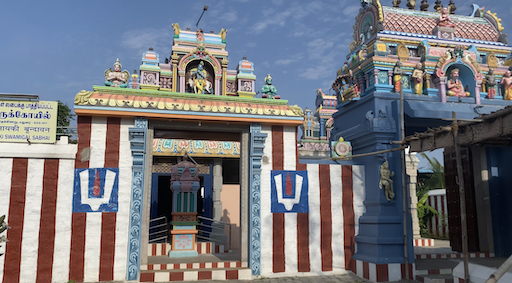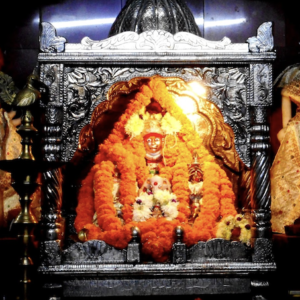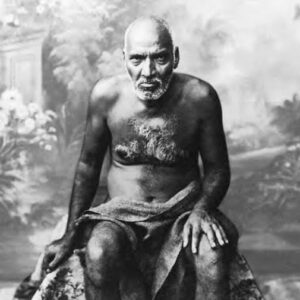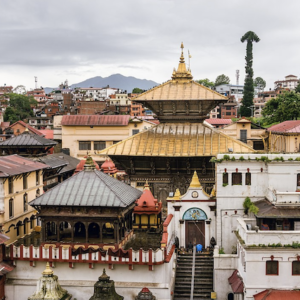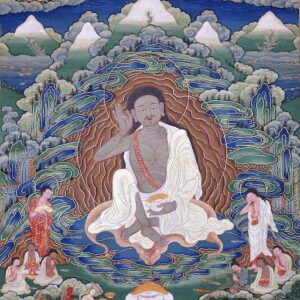This is a Samadhi Brindavanam of Sriman Natana Gopala Nayaki Swamigal. The Cave temple is located on the way from Madurai to Alagar RF.
There is a place to sit and meditate. You can go into meditative states here effortlessly.
How to get there
It is located 9.7 kms North of Madurai.
Map: https://goo.gl/maps/RkSH5VH1R9b9cZqq9
About Sriman Natana Gopala Nayaki Swamigal
Sriman Natanagopala Nayaki Swamigal was born on 9th January, 1843 in Madurai of Tamil Nadu, state of India. His parents Sri. Rengariyar and Lakshimi Ammal named him Rama Bhadran. Even from his childhood he used to sit lonely indulging in deep thinking. Though he was sent to school, he showed no interest in education since it did not pave the way for educating him in spirituality. When he was ten years old, he was sent for a clerical job in a business centre. As he had no interest and enthusiasm in work, he was sent out of the job.
Then his parents sent him to do the family profession of weaving. Though engaged sometimes in weaving, his mind ever fixed in God. He began to meditate even when he was weaving. Swamigal’s father abused him for not doing the duties properly. So he left the house, at the age of sixteen, and went Thirupparankunram and on the backside of the Murugan temple there is a mountain path where he indulged himself in deep meditation at a cave called kukaashram. After some time, the mother of Ramabhadran came to know that he was in the kukaashram cave of Thirupparankunram, and went there. She appealed him to come home and to be married. He refused to return home. But in all humility prevailed upon her, requested to give him a beggar’s bowl (Thiruvodu). The mother did as he said and returned home. He practised deep meditation for twelve years at kukaashram.
2. When Ramabhadran attained at the age of twenty-eight, he went Paramakuti to meet his guru Nagalinga Adigal, as it was the instinct of the divine through dreams. He learnt Siddhi within eighteen days and he was crowned with the name Sadhananda Siddhar by his guru Nagalinga Adigal. During his travel from Paramakuti thro’ Ramnad, he was warmly welcomed and honoured by the Sethupathi Raja of Ramnad Province. While Swamigal was at Sivaganga he was cordially welcomed by the king of Sivaganga. He had an intension of testing the mental calibre and character of Swamigal. A very beautiful woman dancer was sent to the room of his stay. Swamigal saw the woman as the manifestation of the divine mother. The woman went away worshipping the Swamigal.
It was known to the King of Sivagangai province that the Swamigal could be in the state of Samadhi for many days hence he wanted to test the same also. So a room was built under the ground with consent of the Swamigal and that room was occupied by the Swamigal in the presence of so many people. That room was covered with cement and it was watched day and night by watchmen. After forty days, an explosion was heard and when the King was informed about the explosion, he hurried to that place. The watchmen came and informed the king that the Swamigal was going thro’ Madurai Street towards Madurai. We understand the powers of the siddhis of the Swamigal and also how he controlled the body.
3. Swamigal stayed some days in Madurai. He used to go for unchaviruthi once in a month in Madurai, by using the bowl (Thiruvotu given by his mother). Then he traveled to the southern side of Madurai, by walk, with disciples. He reached Alvarthirunagari and obtained Dharsan of Vadapathraararyar . Vadapathraarayar led him to his house and initiated him in the path of Vaishnavism, and did consecration ceremony know as Panchasamskara and deeksha name (Vaishnava name) Natangopal was bestowed on Sadhananda Siddhar. He learned Divyaprabandam, hymns of the the alwaars. He expressed his eternal gratitude by stamping his Guru’s name Vadapathraarayar in all the later verses.
Then he went to Srivilliputhur and worshipped Andal and went to Srirangam there he enjoyed the Bliss of lord of sleeping beauty and he sang and danced in joy. The Jeeyar Swami of Srirangam was much impressed by inordinate love of Natanagopal to Renganada which approximated to that of a lady. The Jeeyar accorded him with the title “Natanagopala Nayaki” and that became his name ever since.
He then set out on a pilgrimage to Thirupathi, Kanchipuram ect. And visited other Perumal temples in other holy cities. On his way back from Thirupathi he came to Thirupuvanam near Kumpakonam. There, a lady received him with great respect and love.She offered silk sari, many ornaments, usually worn by a lady. He accepted them and dressed himself as a lady and put on the jewels also. He then returned Madurai and walked like a lady in the street of Madurai for Unchavirithi. Then he would spend the day in Bajan and Keerthans along with his disciples and devotees.
4. One year in 1912 Vaigunda Ekadasi, at the age of sixty-nine Swamigal was taken around the streets in Madurai in a Palanquin by his disciples and devotees. The next year also on Vaigunda Ekadasi Swamigal was taken in procession in horse coach. Swamigal told his disciples that “Last year procession was in Dandi (Palanquin), this year it was in bondi (coach) next year you shall see the Khandi.” As such he informed his followers about his Mukthi before one year, and the place for his Brindavan to be at Kathakinar on the Madurai Alagar Koil main road and facing of the idol of Lord Narasimha of Yanamalali temple. Swamigal attained Mukthi and reached the abode of Lord Hari on 8th January 1914 Vaigunda ekadasi which in the deatails of the month, day of the week and the constellation exactly with those of the time of his birth. Strange coincidence! Swamigal has composed many songs both in Tamil and Sourashtram language. He advocates people think of Lord Hari always. “When you stand or sit or walk or sleep, don’t forget to chant the holy name Natanagopal (By Sriman Natanagopala Nayaki Swamigal) Swamgial requests the human beings to call Govinda, before the fall of the body, who would free you from the cycle of birth and death. His Bhakthi movment and his devotional songs deal with the philosophies of life.


